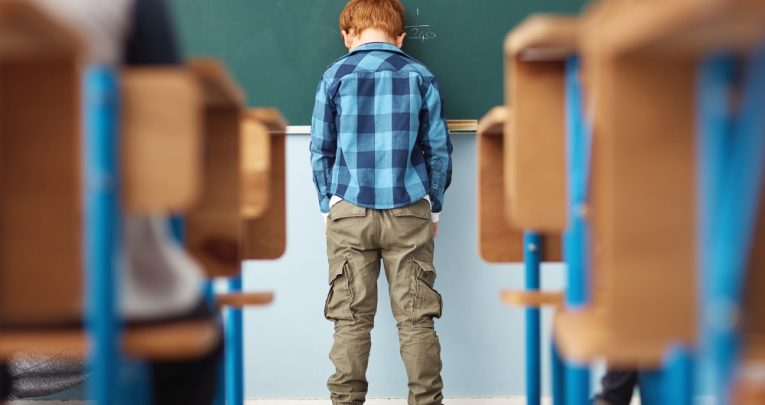Some classroom behaviour management strategies can humiliate children, with long-term consequences

Nicole Dempsey looks at how certain classroom strategies can be more humiliating than initially thought, with regretful long-term consequences…

Picture the scene. You and your colleagues are seated, waiting for your regular in-house CPD session to start. The whiteboard flickers to life. Great, you think, the sooner we can get started, the better.
On the board are displayed two lists of teachers names – including yours – grouped under a happy face and a sad face. You then read the slide title: ‘This term’s good/outstanding (or not) lesson observations’…
An unlikely scenario, I think. I hope! But hypothetically, how would that make you feel? What would it feel like to be publicly identified as belonging on the ‘sad face’ list? How would you feel if you were on the ‘happy face’ list? Would it impact on the relationship you have with your colleagues? And perhaps most importantly – what purpose would it serve to make such information public in this way?
Public humiliation
The start of 2018 has seen professionals from across the education sector speak out on the growing prevalence of ‘zero tolerance’ and ‘no excuses’ behaviour management approaches, and how they discriminate against students with SEND, mental health needs and other vulnerable groups (such as looked after children and those eligible for Pupil Premium). Some have further observed that such policies might be at the root of recent rises in both fixed term and permanent exclusions for the second year running, in which SEND, mental health and Pupil Premium pupils are all over-represented.
Many others have cited the above ‘names on the board’ scenario, though it’s one that’s arguably more prevalent in primary schools than secondary. A scenario more applicable to secondary settings would involve the public verbal reprimand – being put on the spot and asked to account for your behaviour. In our earlier example, imagine each ‘sad face’ teacher having to stand and explain why their particular lesson didn’t match the criteria.
However you try to illustrate them, certain types of behaviour policy result in poor choices, errors of judgement, genuine mistakes, misunderstandings and other things a child can’t help being made very public.
I’m of the view that we shouldn’t be using public humiliation or shaming as a behaviour management tactic – but not because it discriminates against vulnerable students, and not because I don’t agree with ‘zero tolerance’ or ‘no excuses’ cultures (which can mean different things in different schools). Nor am I opposed to them because I think it ‘names and fames’, rather ‘names and shames’ students (as suggested in Paul Dix in his book When The Adults Change Everything Changes). Public reprimands may outwardly seem to result in a display of bravado, but I really don’t believe that any child revels in being humiliated in front of their peers.
They may, however, become a self-fulfilling prophecy. It may be easier for children, emotionally, to go with the process than actively resist it. In a relationship with such a power disparity, what other option do they actually have? No, I disagree with public humiliation as a behaviour management tactic for a different reason.
You see, all children are ‘vulnerable’ simply by virtue of being children. In a teacher/ student relationship there’s inevitably an imbalance of power. You’re an adult, in a position of authority who’s chosen to be there, and you absolutely have the upper hand.
Repurcussions
With a young person who has additional learning needs, mental health needs, challenges in their home and other specific vulnerabilities, you may see repercussions as a result of their embarrassment. They may become angry, upset or withdrawn. Or maybe you’ll feel remorse when you remember which of those lists they’re on.
There may be no such repercussions if you use the same approach with one of your more resilient learners, but this doesn’t mean it’s okay to emotionally abuse them. The care, kindness, consideration and individualisation we afford our most vulnerable students is the right of every student. By the same token, the high expectations, quality and accountability we provide to our most able students is the entitlement of every other student too.
It may not always feel like it, but you have all the power in the classroom. You’re the adult, you get to set the rules, so you need to use that power wisely. You need to not abuse it. In your relationships with your students you need to be conscious of the position of power you’re in and be the bigger person. Winning an argument with an angry and upset child isn’t winning. Backing a child into a corner, be it literally or metaphorically, isn’t winning. Using your status to embarrass a child in front of peers they have to spend nearly all of every day with isn’t winning. If you do any of those things and receive a backlash, you deserve it.
As well as teaching our students the curriculum, the schemes, the ‘We Are Learning To…’ the ‘What I’m Looking For…’ and whatever else, we’re also teaching them how to function in a community, how to behave in society and how to be a good citizen.
How we respond to them shows them how to respond to others, and like everything else we’re teaching them, this needs to be considered and controlled. Give them the response that teaches them how their actions can make those around them feel and react. Are you angry? Are you disappointed, annoyed, inconvenienced or hurt?
Society has nothing to gain from teaching our children that those in positions of power will publicly humiliate you when you get it wrong. No one benefits from making the next generation of adults angry, resentful and lacking in trust.
If you wouldn’t be comfortable explaining your actions or remarks to a parent, or if you wouldn’t be happy hearing a similar explanation from a teacher who’d done the same to your child, then you probably shouldn’t be doing or saying those things in the first place.
Gain without shame
1. Be clear Lead with pupils’ names – say what you mean and mean what you say. Don’t say ‘please’ unless it’s a plea, and avoid sarcasm, idiom or rhetoric. Say why you’re doing something. If you can’t explain why, don’t do it.
2. Never back a child into a corner No matter what’s happened or how far a situation’s gone, there should always be a positive choice the child can make for themselves. This doesn’t mean they’ve ‘got away with it’; it means that they can learn from it.
3. Winning an argument isn’t winning Approach even the most challenging situation with compassion and kindness. They aren’t going to learn whatever you want them to be learning when in such an aroused state. They could, however, learn that you are fair and understanding. Deal with whatever the behaviour issue was when they (and you!) are calmer.
4. Unconditional positive regard The student who challenges you most is the student that needs you the most. Be their champion.
Nicole Dempsey is head of the Mountain Rescue team at Dixons Trinity Academy. Read about behaviour management strategies for secondary.












